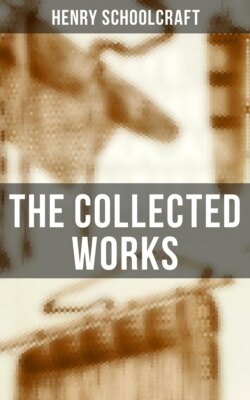Читать книгу The Collected Works - Henry Rowe Schoolcraft - Страница 59
На сайте Литреса книга снята с продажи.
FOOTNOTES:
Оглавление1. Detached pieces of calcareous tufa were found, imbedded in the soil, at the mouth of the river Brule, in 1832.
2. Relation des traverses et des aventures d’un Marchand Voyageur dans les territoires Sauvages de l’Amérique Septentrionale, parti de Montreal, le 28 de Mai, 1783. Par Jean Baptiste Pérault.
3. Wabidea.
4. He had returned with the Expedition, from Lake Superior.
5. It is believed that the American Fur Company, did, however, submit such a proposition to the Directors of the Hudson’s Bay Company in London, which was not acceded to by the latter.
6. Or Pami-tascodiac.
7. From the data, above given, the descent of the Mississippi, will average a fraction over five inches, per mile, a result not essentially different from that furnished by the data, which I submitted in my Narrative Journal in 1820, but which was differently stated from haste and inadvertence. For a prompt notice of the error, I feel indebted to Hamilton Fulton, Esqr., who, soon after the appearance of the work, wrote to my publishers, on the subject.
8. Onzig, of the Chippewas.
9. So called in honor of Lieut. James Allen, U. S. A. who, on his return down the Mississippi, was the first to explore it.
10. A few years ago, a Mr. Beltrami, returning from the settlement of Pembina, by the usual route of the traders from Red Lake to Turtle Lake, published at New Orleans, a small 12mo volume under the title of “La découverte des sources du Mississippi, et de la Rivière Sanglante,” a work which has since been expanded into two heavy 8vo volumes by the London press.
11. Composed of the initials of the names of the gentlemen of the party.
12. Among the dead, Wahb Ojeeg, Cadiwabida, or the Brèche, Chingaba Wossin, and Mozobodo, are the Chippewa patriarchs of modern days.
13. It has been stated in the “Preliminary Observations,” that it became impracticable to visit these bands, during the expedition of 1831.
14. Prairie du Chien.
15. St. Peter’s.
16. Family mark, or coat of arms—a kind of surname.
17. Report of the proceedings connected with the disputes between the Earl of Selkirk and the North West Company, at the assizes held at York in Upper Canada, Oct. 1818. Montreal. 8vo. 564 p.
18. Genera Unio, Anodonta, alasmadonta.
19. This Chief attacked a Sioux war party, which imprudently ventured in the vicinity, in the fall of this year, (1832,) and achieved a victory, in which he killed forty persons, and lost not a single man.
20. The total descent of the river at these falls, including the rapids above and below them, is stated in my “Narrative Journal of Travels to the Sources of the Mississippi,” at 65 feet, an estimate which it is believed may exceed the actual aggregate descent, and certainly does so, in the hasty estimate which is given of the perpendicular fall.
21. I am not certain that I fully comprehend the brevity of Mr. Eaton’s division of this formation of the English geologists; but if I do so, he deduces from it, or from its equivalent in American geology, 1. Second graywake, 2. Calciferous sand-rock, 3. Silicious lime rock, 4. Metalliferous limerock.
22. Alluding to a mound on an eminence at the mouth of the river.
23. Vide Letter to his Excellency Gov. Porter, in the Appendix.
24. This island has been the scene of a subsequent murder, in which an Indian was excited to kill his father-in-law.
25. The Crane is the totem of the reigning chiefs of the band of Sault Ste. Marie.
26. The double vowel is here employed to indicate the long sound of i, as i in machine.
27. Perhaps Aurikerees, and Ornapas.
28. Vide sequel.
29. See this reported, as modified by subsequent accounts.
30. Louis Dufault.
31. St. Peters.
32. Signature is expressed by the ceremony of making their mark.
33. On my arrival at the Petite Corbeau’s village his people fired a salute with ball, and after making further remarks on the state of their affairs, he presented me a peace-pipe and stem.
34. I enclose the copy of a letter on the subject of posts, &c., addressed by me to Gen. S. M. Street, Agent at Prairie du Chien.
35. I annex the speech of Mozobodo, chief of Torch Lake, on this subject.
36. Buffalo, of Folle Avoine.
Chäcopi, of Snake River.
Nodin, of do.
Läbaince, of Yellow River.
The Little Frenchman, of Folle Avoine.
Keeshkitowug, of Yellow River.
37. The Indians personify the government in the agent, commissioner, &c. they are addressing.
38. This term is in use by the Algic or Algonquin tribes, particularly by the Chippewas. The Winnebagoes, who have no equivalent for it, are generally acquainted with it, although I am not aware that they have, to any extent, adopted it. It has been supposed to be derived from the French bon jour.
